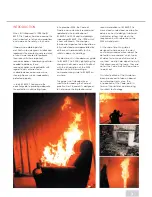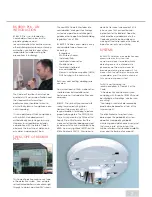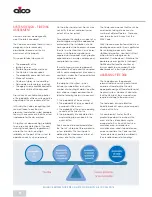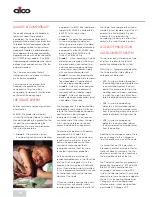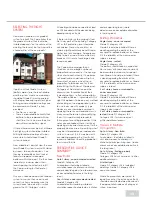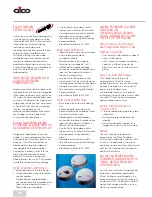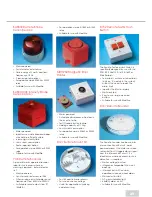
10
People with impaired mobility require
more time to escape. They need the
earliest possible warning of a fire and
greater alarm coverage. The hearing
impaired also have very particular
needs, and these are dealt with later in
this document.
It is obvious to any landlord - in the
public or private sector - that those
judged to be most at risk and in need
of a high level of protection are those
who form a typical cross section of
their tenants.
PROPERTY PROTECTION
BS 5839: Pt.6 also adds other
considerations for the protection of
property. However, it stresses that only in
exceptional circumstances, for example
in a house of historical importance
where no-one sleeps, should the
principle objective of a fire detection
system ever be the preservation of
property rather than lives.
If property damage is the decisive
factor, the Code recommends
installing a system which results in the
fire brigade being called early enough
to limit property damage.
As a fire that starts anywhere will cause
damage, consideration should be given
to providing detectors in some or all
rooms of the building. Coverage in
circulation areas alone is unlikely to be
adequate. Once again, areas with a
statistically greater fire risk, such as
kitchens and boiler rooms, where likely
sources of ignition are present, should
have priority for detectors.
Property damage should, of course,
never be a deciding factor for a
landlord, but it is worth bearing in mind
not only the human cost but also the
financial cost of a fire breaking out in
a property. Insurance premiums may
rise, renovation costs may be
expensive and revenue from the
property will be lost while it is being
made habitable, to say nothing of the
cost of re-housing tenants. Once
again, the cost-effectiveness of a
quality fire alarm system offering the
earliest possible warning is self-evident.
TYPES OF ALARM
TECHNOLOGY
The next issue raised by the Code is
the types of alarm available.
BATTERY OPERATED
SMOKE ALARMS - GRADE F
BS 5839: Pt.6 acknowledges the
advantages of the single, battery
operated smoke alarm. They’re
simple to install and offer protection
at very low cost. Battery operated
smoke alarms conforming to BS
5446: Pt.1 are recommended.
However, these alarms do have
serious drawbacks. Occupants on
a tight budget may not be able to
afford to replace the batteries. A
significant number of tenants have
also been shown to remove the
batteries to prevent false alarms or
to use in other battery powered
devices and then forget to replace
them. For this reason, the Code
recommends that these alarms
should not be used to protect
tenants in properties of more than
one storey – and even then the
batteries should be sealed-in and
have a life in excess of 5 years.
As an aside, landlords have now
been found liable in cases where
tenants themselves have disabled
an alarm. For this reason, it is
unlikely that landlords will be able
to trust tenants to adequately look
after the alarms. The Code
highlights the fact that battery
powered alarms are only suitable
for owner-occupied properties if
the likelihood is that batteries will
be replaced within five days of a
low battery signal.
Interestingly, the Code acknowledges
that people on a low income are
more at risk than other groups, which
is borne out by statistics from the
British Crime Survey. They may not be
able to afford to replace batteries in
smoke alarms and the Code
consequently points out that ‘a more
reliable power supply for the fire
detection and alarm system is
essential’. This worry, coupled with the
fear of alarms being cut off to poorer
residents along with their electricity
supply, permeates the entire
document and needs to be stressed.
People living in a house in multiple
occupation are between eight and
ten times more likely to die in a fire
than those in single family homes, it
has been estimated. However, the
Code distinguishes between
properties commonly designated as
HMOs. On the one hand, a family
living with a lodger might not be
classed as an HMO as the fire risk may
be no greater than a normal dwelling.
It identifies the greatest risk in houses
converted into bedsits and to elderly
people in sheltered accommodation.
Generally, the risk is also greater if the
property exceeds two storeys in
height. Here the Code recommends
“where the risk in an HMO is relatively
high, it is essential that there is
protection by a highly reliable fire
detection and fire alarm system. It is
also essential that a warning is given
in the event of a fault that impairs the
standard of protection”.



